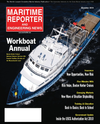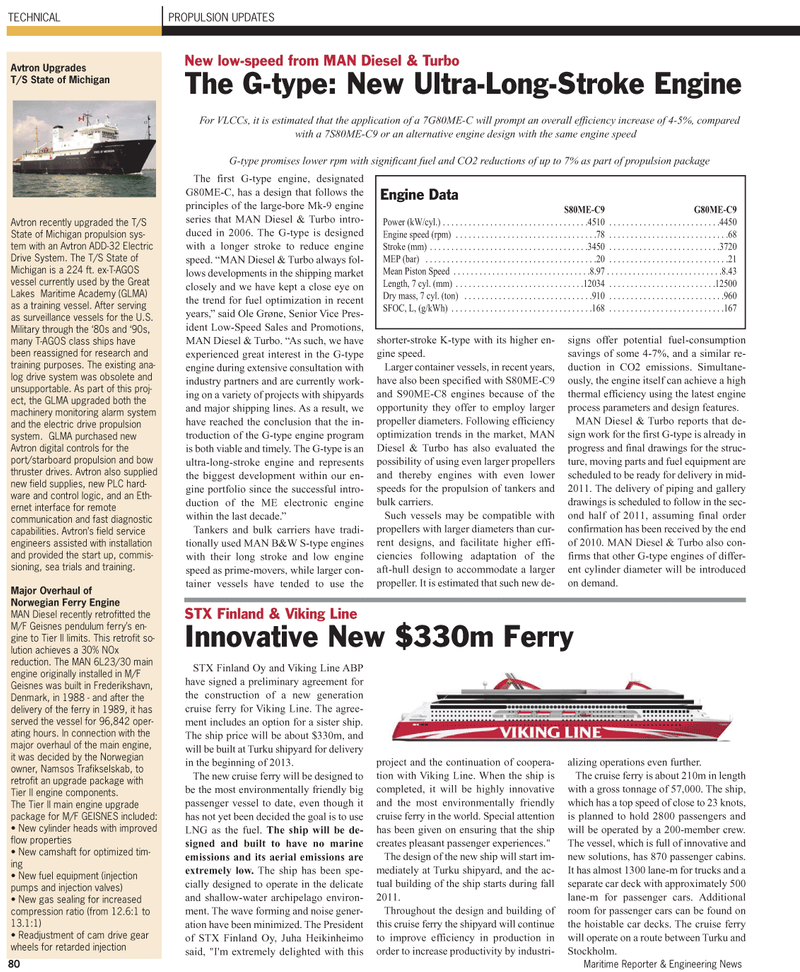
Page 82: of Maritime Reporter Magazine (November 2010)
Workboat Annual
Read this page in Pdf, Flash or Html5 edition of November 2010 Maritime Reporter Magazine
80 Maritime Reporter & Engineering News
TECHNICAL PROPULSION UPDATES
The first G-type engine, designated
G80ME-C, has a design that follows the principles of the large-bore Mk-9 engine series that MAN Diesel & Turbo intro- duced in 2006. The G-type is designed with a longer stroke to reduce engine speed. “MAN Diesel & Turbo always fol- lows developments in the shipping market closely and we have kept a close eye on the trend for fuel optimization in recent years,” said Ole Grøne, Senior Vice Pres- ident Low-Speed Sales and Promotions,
MAN Diesel & Turbo. “As such, we have experienced great interest in the G-type engine during extensive consultation with industry partners and are currently work- ing on a variety of projects with shipyards and major shipping lines. As a result, we have reached the conclusion that the in- troduction of the G-type engine program is both viable and timely. The G-type is an ultra-long-stroke engine and represents the biggest development within our en- gine portfolio since the successful intro- duction of the ME electronic engine within the last decade.”
Tankers and bulk carriers have tradi- tionally used MAN B&W S-type engines with their long stroke and low engine speed as prime-movers, while larger con- tainer vessels have tended to use the shorter-stroke K-type with its higher en- gine speed.
Larger container vessels, in recent years, have also been specified with S80ME-C9 and S90ME-C8 engines because of the opportunity they offer to employ larger propeller diameters. Following efficiency optimization trends in the market, MAN
Diesel & Turbo has also evaluated the possibility of using even larger propellers and thereby engines with even lower speeds for the propulsion of tankers and bulk carriers.
Such vessels may be compatible with propellers with larger diameters than cur- rent designs, and facilitate higher effi- ciencies following adaptation of the aft-hull design to accommodate a larger propeller. It is estimated that such new de- signs offer potential fuel-consumption savings of some 4-7%, and a similar re- duction in CO2 emissions. Simultane- ously, the engine itself can achieve a high thermal efficiency using the latest engine process parameters and design features.
MAN Diesel & Turbo reports that de- sign work for the first G-type is already in progress and final drawings for the struc- ture, moving parts and fuel equipment are scheduled to be ready for delivery in mid- 2011. The delivery of piping and gallery drawings is scheduled to follow in the sec- ond half of 2011, assuming final order confirmation has been received by the end of 2010. MAN Diesel & Turbo also con- firms that other G-type engines of differ- ent cylinder diameter will be introduced on demand.
Avtron Upgrades
T/S State of Michigan
Avtron recently upgraded the T/S
State of Michigan propulsion sys- tem with an Avtron ADD-32 Electric
Drive System. The T/S State of
Michigan is a 224 ft. ex-T-AGOS vessel currently used by the Great
Lakes Maritime Academy (GLMA) as a training vessel. After serving as surveillance vessels for the U.S.
Military through the ‘80s and ‘90s, many T-AGOS class ships have been reassigned for research and training purposes. The existing ana- log drive system was obsolete and unsupportable. As part of this proj- ect, the GLMA upgraded both the machinery monitoring alarm system and the electric drive propulsion system. GLMA purchased new
Avtron digital controls for the port/starboard propulsion and bow thruster drives. Avtron also supplied new field supplies, new PLC hard- ware and control logic, and an Eth- ernet interface for remote communication and fast diagnostic capabilities. Avtron’s field service engineers assisted with installation and provided the start up, commis- sioning, sea trials and training.
Major Overhaul of
Norwegian Ferry Engine
MAN Diesel recently retrofitted the
M/F Geisnes pendulum ferry’s en- gine to Tier II limits. This retrofit so- lution achieves a 30% NOx reduction. The MAN 6L23/30 main engine originally installed in M/F
Geisnes was built in Frederikshavn,
Denmark, in 1988 - and after the delivery of the ferry in 1989, it has served the vessel for 96,842 oper- ating hours. In connection with the major overhaul of the main engine, it was decided by the Norwegian owner, Namsos Trafikselskab, to retrofit an upgrade package with
Tier II engine components.
The Tier II main engine upgrade package for M/F GEISNES included: • New cylinder heads with improved flow properties • New camshaft for optimized tim- ing • New fuel equipment (injection pumps and injection valves) • New gas sealing for increased compression ratio (from 12.6:1 to 13.1:1) • Readjustment of cam drive gear wheels for retarded injection
New low-speed from MAN Diesel & Turbo
The G-type: New Ultra-Long-Stroke Engine
For VLCCs, it is estimated that the application of a 7G80ME-C will prompt an overall efficiency increase of 4-5%, compared with a 7S80ME-C9 or an alternative engine design with the same engine speed
G-type promises lower rpm with significant fuel and CO2 reductions of up to 7% as part of propulsion package
STX Finland Oy and Viking Line ABP have signed a preliminary agreement for the construction of a new generation cruise ferry for Viking Line. The agree- ment includes an option for a sister ship.
The ship price will be about $330m, and will be built at Turku shipyard for delivery in the beginning of 2013.
The new cruise ferry will be designed to be the most environmentally friendly big passenger vessel to date, even though it has not yet been decided the goal is to use
LNG as the fuel. The ship will be de- signed and built to have no marine emissions and its aerial emissions are extremely low. The ship has been spe- cially designed to operate in the delicate and shallow-water archipelago environ- ment. The wave forming and noise gener- ation have been minimized. The President of STX Finland Oy, Juha Heikinheimo said, "I'm extremely delighted with this project and the continuation of coopera- tion with Viking Line. When the ship is completed, it will be highly innovative and the most environmentally friendly cruise ferry in the world. Special attention has been given on ensuring that the ship creates pleasant passenger experiences."
The design of the new ship will start im- mediately at Turku shipyard, and the ac- tual building of the ship starts during fall 2011.
Throughout the design and building of this cruise ferry the shipyard will continue to improve efficiency in production in order to increase productivity by industri- alizing operations even further.
The cruise ferry is about 210m in length with a gross tonnage of 57,000. The ship, which has a top speed of close to 23 knots, is planned to hold 2800 passengers and will be operated by a 200-member crew.
The vessel, which is full of innovative and new solutions, has 870 passenger cabins.
It has almost 1300 lane-m for trucks and a separate car deck with approximately 500 lane-m for passenger cars. Additional room for passenger cars can be found on the hoistable car decks. The cruise ferry will operate on a route between Turku and
Stockholm.
Engine Data
S80ME-C9 G80ME-C9
Power (kW/cyl.) . . . . . . . . . . . . . . . . . . . . . . . . . . . . . . . . . .4510 . . . . . . . . . . . . . . . . . . . . . . . . . .4450
Engine speed (rpm) . . . . . . . . . . . . . . . . . . . . . . . . . . . . . . . . .78 . . . . . . . . . . . . . . . . . . . . . . . . . . . .68
Stroke (mm) . . . . . . . . . . . . . . . . . . . . . . . . . . . . . . . . . . . . .3450 . . . . . . . . . . . . . . . . . . . . . . . . . .3720
MEP (bar) . . . . . . . . . . . . . . . . . . . . . . . . . . . . . . . . . . . . . . . .20 . . . . . . . . . . . . . . . . . . . . . . . . . . . .21
Mean Piston Speed . . . . . . . . . . . . . . . . . . . . . . . . . . . . . . . .8.97 . . . . . . . . . . . . . . . . . . . . . . . . . . .8.43
Length, 7 cyl. (mm) . . . . . . . . . . . . . . . . . . . . . . . . . . . . . .12034 . . . . . . . . . . . . . . . . . . . . . . . . .12500
Dry mass, 7 cyl. (ton) . . . . . . . . . . . . . . . . . . . . . . . . . . . . . .910 . . . . . . . . . . . . . . . . . . . . . . . . . . .960
SFOC, L, (g/kWh) . . . . . . . . . . . . . . . . . . . . . . . . . . . . . . . . .168 . . . . . . . . . . . . . . . . . . . . . . . . . . .167
STX Finland & Viking Line
Innovative New $330m Ferry

 81
81

 83
83
